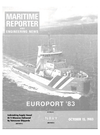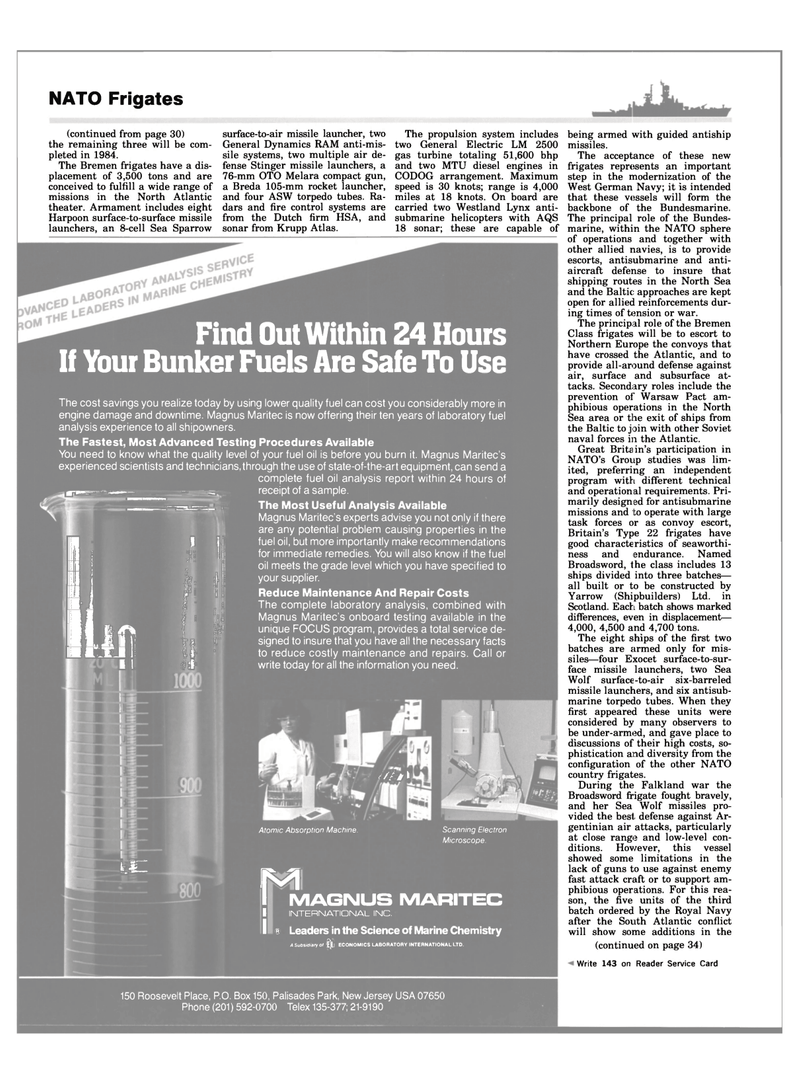
Page 34: of Maritime Reporter Magazine (October 15, 1983)
Read this page in Pdf, Flash or Html5 edition of October 15, 1983 Maritime Reporter Magazine
NATO Frigates (continued from page 30) the remaining three will be com- pleted in 1984.
The Bremen frigates have a dis- placement of 3,500 tons and are conceived to fulfill a wide range of missions in the North Atlantic theater. Armament includes eight
Harpoon surface-to-surface missile launchers, an 8-cell Sea Sparrow surface-to-air missile launcher, two
General Dynamics RAM anti-mis- sile systems, two multiple air de- fense Stinger missile launchers, a 76-mm OTO Melara compact gun, a Breda 105-mm rocket launcher, and four ASW torpedo tubes. Ra- dars and fire control systems are from the Dutch firm HSA, and sonar from Krupp Atlas.
Find Out Within 24 Hours
If Your Bunker Fuels Are Safe To Use
The cost savings you realize today by using lower quality fuel can cost you considerably more in engine damage and downtime. Magnus Maritec is now offering their ten years of laboratory fuel analysis experience to all shipowners.
The Fastest, Most Advanced Testing Procedures Available
You need to know what the quality level of your fuel oil is before you burn it. Magnus Maritec's experienced scientists and technicians, through the use of state-of-the-art equipment, can send a complete fuel oil analysis report within 24 hours of a- —receipt of a sample.
H _ ^ The Most Useful Analysis Available
Magnus Maritec's experts advise you not only if there are any potential problem causing properties in the | fuel oil, but more importantly make recommendations | for immediate remedies. You will also know if the fuel i oil meets the grade level which you have specified to | your supplier. ( Reduce Maintenance And Repair Costs ! The complete laboratory analysis, combined with f Magnus Maritec's onboard testing available in the | k 9 unique FOCUS program, provides a total service de- [ | signed to insure that you have all the necessary facts
I to reduce costly maintenance and repairs. Call or ! write today for all the information you need. -EE
Atomic Absorption Machine. ///# >
Scanning Electron
Microscope.
M
I IN"
I I® Le
MAGNUS MARITEC
INTERNATIONAL INC.
Leaders in the Science of Marine Chemistry
A Subsidiary of fj. ECONOMICS LABORATORY INTERNATIONAL LTD.
The propulsion system includes two General Electric LM 2500 gas turbine totaling 51,600 bhp and two MTU diesel engines in
CODOG arrangement. Maximum speed is 30 knots; range is 4,000 miles at 18 knots. On board are carried two Westland Lynx anti- submarine helicopters with AQS 18 sonar; these are capable of being armed with guided antiship missiles.
The acceptance of these new frigates represents an important step in the modernization of the
West German Navy; it is intended that these vessels will form the backbone of the Bundesmarine.
The principal role of the Bundes- marine, within the NATO sphere of operations and together with other allied navies, is to provide escorts, antisubmarine and anti- aircraft defense to insure that shipping routes in the North Sea and the Baltic approaches are kept open for allied reinforcements dur- ing times of tension or war.
The principal role of the Bremen
Class frigates will be to escort to
Northern Europe the convoys that have crossed the Atlantic, and to provide all-around defense against air, surface and subsurface at- tacks. Secondary roles include the prevention of Warsaw Pact am- phibious operations in the North
Sea area or the exit of ships from the Baltic to join with other Soviet naval forces in the Atlantic.
Great Britain's participation in
NATO's Group studies was lim- ited, preferring an independent program with different technical and operational requirements. Pri- marily designed for antisubmarine missions and to operate with large task forces or as convoy escort,
Britain's Type 22 frigates have good characteristics of seaworthi- ness and endurance. Named
Broadsword, the class includes 13 ships divided into three batches— all built or to be constructed by
Yarrow (Shipbuilders) Ltd. in
Scotland. Each batch shows marked differences, even in displacement— 4,000, 4,500 and 4,700 tons.
The eight ships of the first two batches are firmed only for mis- siles—four Exocet surface-to-sur- face missile launchers, two Sea
Wolf surface-to-air six-barreled missile launchers, and six antisub- marine torpedo tubes. When they first appeared these units were considered by many observers to be under-armed, and gave place to discussions of their high costs, so- phistication and diversity from the configuration of the other NATO country frigates.
During the Falkland war the
Broadsword frigate fought bravely, and her Sea Wolf missiles pro- vided the best, defense against Ar- gentinian air attacks, particularly at close range and low-level con- ditions. However, this vessel showed some limitations in the lack of guns to use against enemy fast attack craft or to support am- phibious operations. For this rea- son, the five units of the third batch ordered by the Royal Navy after the South Atlantic conflict will show some additions in the (continued on page 34)
Write 143 on Reader Service Card 150 Roosevelt Place, P.O. Box 150, Palisades Park, New Jersey USA 07650
Phone (201) 592-0700 Telex 135-377; 21-9190

 33
33

 35
35
